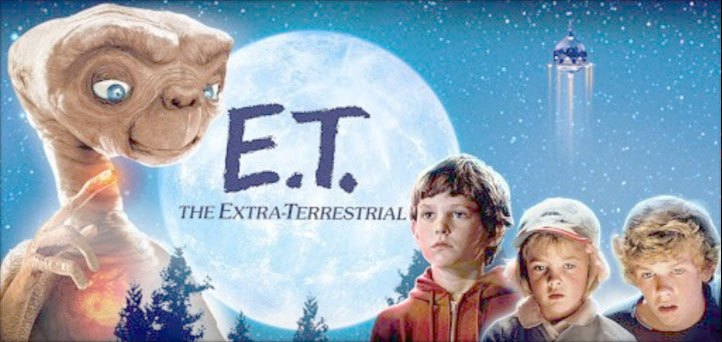E.T. the Extra-Terrestrial

“E.T. the Extra-Terrestrial,” directed by Steven Spielberg and released in 1982, is a timeless classic in the realm of science fiction and family cinema. This film, which has touched the hearts of audiences for decades, explores themes of friendship, empathy, and the wonder of the unknown. With its compelling narrative, groundbreaking special effects, and deeply emotional storytelling, “E.T.” stands as a monumental achievement in filmmaking.
The film centers on Elliott (Henry Thomas), a young boy who discovers an alien creature stranded on Earth after a failed attempt by extraterrestrial beings to return to their home planet. The alien, affectionately named E.T. (voiced and performed by Dee Wallace and a team of puppeteers), is a gentle and curious being who befriends Elliott and his siblings, Gertie (Drew Barrymore) and Michael (Robert MacNaughton). As the children bond with E.T., they must keep his presence a secret from the government and work together to help him return to his home planet before it’s too late.

Steven Spielberg, known for his ability to create emotionally resonant and visually captivating films, brings his signature touch to “E.T. the Extra-Terrestrial.” Spielberg’s direction is characterized by its warmth and sensitivity, allowing the film to connect with audiences of all ages. His ability to craft a story that is both fantastical and deeply personal is central to the film’s enduring appeal.
Spielberg’s vision is evident in the film’s portrayal of childhood wonder and the magic of discovery. The way he captures the sense of awe and curiosity in Elliott’s interactions with E.T. reflects a profound understanding of the innocence and imagination of youth. The film’s narrative unfolds with a sense of wonder and optimism, inviting viewers to experience the joy of discovery alongside its young protagonists.

“E.T.” is renowned for its innovative special effects and design, which were groundbreaking at the time of its release. The practical effects used to bring E.T. to life were a marvel of craftsmanship, combining animatronics and puppetry to create a believable and endearing alien character. The film’s effects team, led by special effects supervisor Carlo Rambaldi, achieved a level of realism that allowed audiences to fully engage with E.T.’s emotional journey.
The film’s design and cinematography, overseen by Allen Daviau, contribute to its otherworldly yet familiar atmosphere. The depiction of E.T.’s spaceship and the alien’s interactions with the earthly environment are rendered with a careful balance of realism and fantasy. The visual style of the film, with its warm color palette and evocative imagery, enhances the emotional impact of the story and reinforces its themes of connection and wonder.

One of the film’s most significant achievements is its emotional resonance. “E.T.” explores themes of loneliness, friendship, and the longing for connection, making it a deeply affecting experience. The relationship between Elliott and E.T. is at the heart of the film, and it is portrayed with a sensitivity and authenticity that elicit genuine empathy from the audience.
Henry Thomas’s portrayal of Elliott is both heartfelt and relatable, capturing the character’s sense of wonder and vulnerability. His performance, along with Drew Barrymore’s charming portrayal of Gertie and Robert MacNaughton’s supportive role as Michael, contributes to the film’s emotional depth. The bond between the characters and E.T. is depicted with a sincerity that makes the alien’s plight and eventual departure deeply moving.
“E.T. the Extra-Terrestrial” has left a lasting impact on popular culture and cinema. Its influence extends beyond its genre, shaping the way that films approach themes of childhood and extraterrestrial life. The film’s iconic imagery, such as the scene of Elliott and E.T. flying on a bicycle against the moonlit sky, has become ingrained in the collective cultural consciousness.
The film’s success was not only reflected in its box office performance but also in its critical acclaim. “E.T.” was nominated for nine Academy Awards and won four, including Best Original Score for John Williams’s memorable and emotional score. Williams’s music, with its poignant melodies and uplifting themes, plays a crucial role in enhancing the film’s emotional impact and has become one of his most celebrated compositions.
The film’s legacy continues to endure, with its themes of empathy, friendship, and the joy of discovery resonating with new generations of viewers. “E.T.” has been celebrated for its ability to capture the essence of childhood wonder and the importance of human connection, making it a timeless classic that remains beloved by audiences of all ages.

“E.T. the Extra-Terrestrial” is a masterful blend of fantasy, emotion, and innovation that has secured its place as one of the most cherished films in cinematic history. Directed by Steven Spielberg and featuring groundbreaking special effects, a heartfelt story, and memorable performances, the film offers a poignant exploration of friendship and the wonders of the unknown. Its impact on popular culture and its enduring appeal speak to the universal themes and emotional depth that make “E.T.” a true cinematic treasure.











